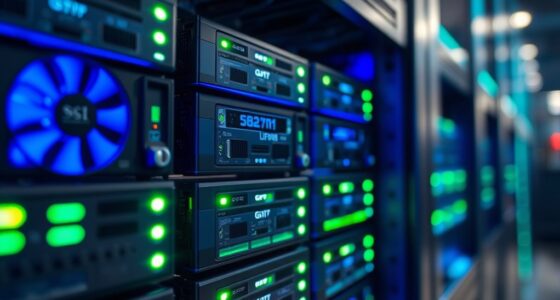Speaker diarization helps you turn chaotic audio recordings into organized conversations by automatically identifying who spoke when. It analyzes voice features like pitch and tone, then groups segments based on speaker identity. This process saves you hours of manual effort, producing clear, labeled transcripts and making interactions easier to understand. If you keep exploring, you’ll discover how this technology can transform your audio analysis and improve your workflow even further.
Key Takeaways
- Speaker diarization automatically identifies “who spoke when,” transforming raw audio into organized, understandable conversations.
- It analyzes voice features to cluster speech segments by speaker, even with overlapping or similar voices.
- This technology streamlines audio analysis, saving time on manual labeling and enabling accurate transcripts.
- It provides insights into conversation dynamics, such as dominant speakers and interaction patterns.
- Speaker diarization enhances various applications like legal, customer service, media, and automated transcription workflows.

Speaker diarization is a technology that automatically identifies “who spoke when” in an audio recording. It’s like giving your recordings a voice map, breaking down long conversations into manageable, understandable segments. Imagine listening to a lengthy meeting or interview, and instead of sifting through hours of audio, you get a clear timeline showing each speaker’s turns. That’s what diarization does—it turns chaos into clarity.
When you use speaker diarization, you don’t need to manually label each speaker or guess who’s talking at any given moment. Instead, the technology analyzes the audio, detects unique voice features, and clusters segments based on speaker identity. This process is fast and highly accurate, even when the speakers’ voices are similar or the audio quality isn’t perfect. This makes it a game-changer for businesses, researchers, and media producers who need to manage large volumes of audio data efficiently.
You might wonder how it works under the hood. The system first processes the audio to extract voice features, like pitch and tone. Then, it compares these features across the recording, grouping similar voice segments together. Think of it as creating a playlist where each voice is a different song, and the system sorts all the clips by the singer. Over time, the system learns to distinguish between speakers, even if they speak over each other or switch places frequently.
Using speaker diarization can save you hours of manual editing. Instead of listening to entire recordings multiple times, you get a structured transcript with labeled segments. This is especially useful in legal proceedings, customer service calls, or media interviews, where knowing who said what is vital. It also enhances the accuracy of automated transcription services, providing more reliable and contextualized transcripts.
Moreover, the technology helps in analyzing conversations for patterns, such as identifying dominant speakers or understanding interaction dynamics. It can even be integrated with other AI tools like speech recognition and sentiment analysis, turning raw audio into actionable insights. As you adopt this technology, you’ll notice how it simplifies workflows, improves data organization, and makes large-scale audio analysis feasible.
In essence, speaker diarization transforms complex audio recordings into clear, organized conversations. It empowers you to handle audio data more effectively, ensuring that every voice is recognized and properly attributed. This makes your work more efficient, your insights more accurate, and your understanding of conversations more profound. Additionally, speaker diarization can be an essential component in addressing cheating or deception detection in various applications, enhancing the integrity of audio analysis.
Frequently Asked Questions
How Does Speaker Diarization Handle Overlapping Speech Segments?
Speaker diarization handles overlapping speech by using advanced algorithms that analyze audio features and identify multiple speakers simultaneously. You’ll notice it segments the audio into distinct speaker labels, even when voices overlap. These systems leverage deep learning models to distinguish individual voices in real-time, allowing you to accurately separate conversations. While challenging, modern diarization tools are increasingly effective at managing overlapping speech, making conversations clearer and easier to follow.
What Are the Main Challenges in Real-Time Speaker Diarization?
You face challenges like accurately identifying speakers amid quick exchanges and overlapping speech in real-time settings. Background noise and varying audio quality make it harder to distinguish voices quickly. Processing speed is critical, so your system must analyze data fast enough to keep up with live conversations. Balancing accuracy and latency requires robust algorithms that adapt to dynamic environments, making real-time speaker diarization complex but essential for seamless communication.
How Accurate Is Speaker Diarization With Noisy Audio?
Did you know that noise can reduce diarization accuracy by up to 30%? When audio is noisy, your system struggles to distinguish speakers clearly, leading to errors. You might notice misattributions or missed segments. To improve accuracy, using advanced noise reduction techniques and training models on noisy datasets helps. While perfect accuracy isn’t guaranteed in noisy environments, these strategies can considerably enhance your diarization results.
Can Speaker Diarization Identify Individual Speakers Across Multiple Recordings?
Yes, speaker diarization can identify individual speakers across multiple recordings. You simply need consistent voice features and a well-trained model. It analyzes each recording, recognizes unique voice patterns, and links them to the same speaker in different sessions. Keep in mind, accuracy improves with clear audio and enough training data. This technology helps you track speakers over time, making conversations more organized and easier to analyze.
What Ethical Considerations Arise From Speaker Diarization Technology?
Sure, because who wouldn’t want a sneaky tech that labels your voice as easily as a cat labels its territory? Ethical concerns include privacy invasion, consent issues, and potential misuse of data. You might unwittingly become part of a surveillance system or face biases in voice recognition. It’s essential to balance innovation with responsibility, ensuring your voice isn’t exploited or misinterpreted without your knowledge or approval.
Conclusion
By mastering speaker diarization, you transform chaos into clear conversations—making sense of every voice in a sea of noise. It’s like having a superpower that untangles even the most tangled dialogues, turning chaos into clarity with ease. As you harness this technology, you’ll realize it’s more than just a tool; it’s your secret weapon for understanding conversations in ways you never imagined possible. Get ready to conquer auditory chaos and elevate your communication game to legendary heights!









